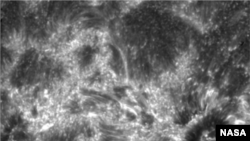NASA's new solar observatory is already giving scientists an unprecedented glimpse of the sun. The U.S. space agency has released the first images from the Interface Region Imaging Spectrograph, known as IRIS, which was launched one month ago.
The images show an active, dynamic region. NASA describes spots that quickly brighten and dim, and thread-like towers of energy that reveal major temperature differences in the sun's lower atmosphere.
The IRIS satellite looks at the little-understood, lowest layers of the sun's atmosphere.
Solving solar mysteries
John Grunsfeld, of NASA's Science Mission Directorate in Washington, described the moment on July 17 when the solar observatory's telescope caught its first glimpse of the sun.
"When the aperture door opened, it was truly a grand opening of a new era of solar physics," he told reporters.
Grunsfeld described the sun's interface region as "a crucial link in that story of unraveling the mysteries of the sun."
Among those mysteries is just how the sun's upper atmosphere is so much hotter than its surface, even though it's farther from the sun's heat-generating core. IRIS observes the way solar material gathers energy and heats up as it rises through the sun's lower atmosphere.
Computer simulations vs. IRIS images
Bart DePontieu, an IRIS researcher based at Lockheed Martin's Advanced Technology Center in California, says scientists have compared computer simulations and the data they've collected from IRIS.
"We've been struck by the similarities with what IRIS sees, but we also already know that there are differences that are puzzling us," he said. "And, actually, that's where we get excited because it's these discrepancies that tell us that we're missing something in our understanding."
DePontieu says scientists hope to observe large explosions on the sun that can disrupt technology here on Earth, as well as the less dramatic solar moments that affect near-Earth space and our climate.
The $181 million IRIS mission is set to last two years, but scientists say the solar explorer could function much longer.









